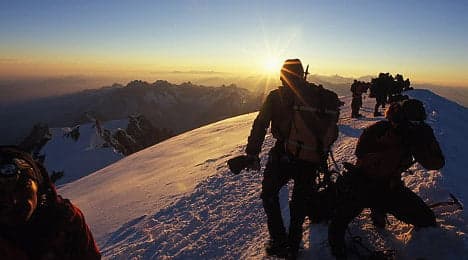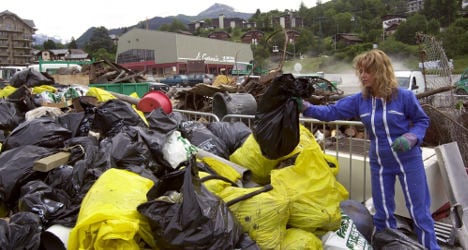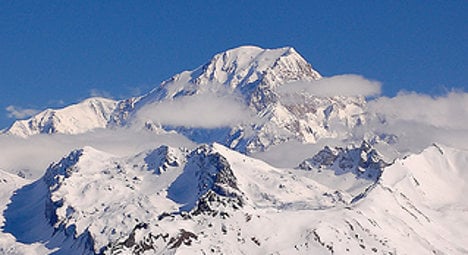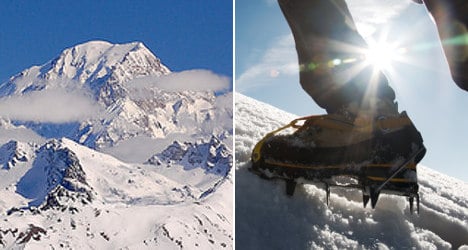Climbing Mont Blanc: 10 reasons to think twice

Always had an urge to stand atop Europe's highest mountain, Mont blanc? Well there's a few things you really need to think about it before you head to the Alps. But don't let us put you off.
For many part-time mountaineers Mont Blanc provides the perfect opportunity to scale a high-altitude mountain, without having to travel to the Himalayas or the Andes. For many of us, it's on our doorstep and then makes the prospect of a shot at the summit even more tempting.
And it's in the Alps, one of Europe's main tourists destinations, so what could go wrong.
But don't be fooled. There's a reason, in fact there's a few, to explain why Mont Blanc has a reputation of being dangerous.
Here's eight reasons to make you think twice about climbing Mont Blanc. (But naturally given the adventurers that we are at The Local, we thoroughly recommend you give it a try, and let us know how you got on.)
Human wave: If you'd pictured yourself alone atop the summit of Europe's highest mountain, with not another soul in sight, it's best you wipe that image away. Because of the fact there are no restrictions to access Mont Blanc, it’s hard to say exactly how many people make the climb to its summit every year, but officials estimate that it is up to 30,000 people per season. While on some days there’s practically nobody, in the summer however, there can be hundreds of people on the main trails at once and during peak season an average of 200 people attempt the summit each day. The mountain huts can be overcrowded meaning many are forced to camp outside, which is actually illegal. The sheer numbers of climbers can lead to bottlenecks on parts of the summit routes and some experts consider the crowds are now danger to the safety of climbers.
Tonnes of trash: The up to 30,000 people who climb Mont Blanc every year leave behind a literal mountain of garbage. Some 500 kilos of trash are carted off the mountain by helicopter each week during the height of the summer climbing season, according to Jean-Marc Peillex, mayor of the town of Saint-Gervais, which sits at the base of the mountain. The mess is primarily produced by people staying in the high altitude huts or in tents part way up the mountain. "We get between 30 and 50 tents at the foot of the Goûter Hut every night with waste everywhere, notably organic. It's disgusting," was how one Mont Blanc guide summed it up last summer. The mountain huts also serve as a collecting point for trash from passing hikers.

(The results of a 2004 trash pick-up in the Mont Blanc Range (Jean-Pierre Clatot/AFP)
Risky routes:Each of the trails up Mont Blanc carry unique dangers and many of the risks overlap. For example the “Le Gôuter” route takes climbers through the “Grand Couloir” which is notorious for falling rocks. While the Trois Monts itinerary includes extra exposure to “seracs” which are massive blocks of ice that tumble from moving glaciers. There’s also the elevated danger of tumbling into a crevasse, or deep crack in a glacier or ice sheet, on the “Grand Mulet” route. It’s worth noting many of these dangers are present no matter where one is on Mont Blanc.
Warm weather avalanches: While the weather may look idyllic peering up at Mont Blanc from Chamonix, down in the valley, things can be a little different high up on the slopes. Mont Blanc is renowned for its rapidly changing weather conditions and even if it's hot and sunny there are still dangers. The kind of clear calm weather that climbers love for ascending Mont Blanc also presents a major risk. Warm temperatures can soften the snowpack and cause it to slide, which means climbers need to leave early enough in the day to not expose themselves to the dangers of avalanches provoked by midday heat. In 2012, nine climbers were killed in an avalanche on Mount Maudit on the popular Three Mounts Traverse route which takes in Mont Blanc? It was one of the worst disasters recorded on the mountain. Rescuers also recommend that climbers carry a snow shovel and a beacon.

Altitude: At 4,810 metres high, the altitude is unlikely to cause any problems for experienced climbers, used to the high peaks of the Andes or Himalayas. But as with many problems surrounding a summit attempt on Mont Blanc, it’s when the one-time climbers take the potential dangers too lightly that problems can arise. People can be affected by the altitude once they get in the region of 2,500 metres up. Altitude sickness, which can affect anyone, even the fittest, can result in symptoms such as nausea, insomnia, vomitting and severe headaches and in extreme circumstances death, although this is unlikely to happen on Mont Blanc. The problems arise when climbers don’t take the time to acclimatise to the altitude and want to get up and down in a couple of days.
Equipment: As you might have gathered by now, Mont Blanc is not just any old uphill stroll and you can’t just turn up in a pair of solid boots, a rain coat and sun glasses and expect to get up. You’ll need to shell out on some decent equipment, although you can hire a fair amount too. Among the items you’ll need are a long handle ice axe, harness, carabineers and crampons, as well as plenty of layers to prepare you for the extreme cold and wind. Just taking a look at this list of recommended equipment might be enough to put some climbers off.

Price: If you are an experienced climber you can attempt Mont Blanc by yourself, but if you are in it for a once-in-a-lifetime experience, then the chances are you’ll need a guide. And guides don’t come cheap. The company Mt Blanc Guides, for example, has set their 2013/14 price at €1975, which includes guiding fees for six days of climbing as well as the costs of the mountain huts and cable cars, although the price can be half that with other companies offering different deals. Added to the cost of a guided climb is the price of travel, food and accommodation costs that you’ll need to stump up before and after the climb. Basically you need deep pockets.
Training: “The message is clear, you either do the suffering during training or you do the suffering during your holiday.” This was how one website introduced its section on the fitness levels needed for summiting Europe’s highest mountain. If you are an occasional runner and a lover of a long walk and think you can climb 4,800 metres just like that, then think again. For a start a lack of fitness could make things dangerous, high up on the mountain and it will also ruin your experience. In terms of a reference, if you have done regular long distance running, even marathons, that should qualify you for a shot at the summit without much training. If not, you’ll need to make sure you’re core muscles are in good shape as well as your heart and lungs. Basically get fit.
Technical skills: Although Mont Blanc is not known as a technical climb, anyone who attempts it will still need to have learned some alpine skills. "Ascending Mont Blanc is not hiking but ALPINISM! The technical skills have to be mastered by the whole team members," reads the guide for climbing Mont Blanc that is subtitled "No, climbing Mont Blanc is not easy". At the very least you'll need to know how to use an ice axe, crampons and ropes, although if you do a guided climb, normally the first couple of days will be spend learning the basic mountaineering skills.
The cold: Even on a bright summers day with Mont Blanc looking resplendent in the sunshine, climbers need to beware of just how cold it can get up at altitude and especially if the weather changes. As the guide states In the Mont Blanc massif, the temperature decreases from between 0.30C to 0.9°C every 100 m in elevation. At the summit of Mont Blanc, a temperature of -15°C without wind corresponds to -30°C with a 60 km/h wind. "In case the pace slows down (fatigue, bad weather, accident…) hypothermia quickly occurs. Be aware of frostbite at extremities (fingers, toes, face, cornea) appearing quickly with cold and windy weather," reads the guide. Ok we'll stop there.
For the sake of balance and just in case we might have put you off here's:
Ten spectacular reasons to climb Mont Blanc
Comments
See Also
For many part-time mountaineers Mont Blanc provides the perfect opportunity to scale a high-altitude mountain, without having to travel to the Himalayas or the Andes. For many of us, it's on our doorstep and then makes the prospect of a shot at the summit even more tempting.
And it's in the Alps, one of Europe's main tourists destinations, so what could go wrong.
But don't be fooled. There's a reason, in fact there's a few, to explain why Mont Blanc has a reputation of being dangerous.
Here's eight reasons to make you think twice about climbing Mont Blanc. (But naturally given the adventurers that we are at The Local, we thoroughly recommend you give it a try, and let us know how you got on.)
Human wave: If you'd pictured yourself alone atop the summit of Europe's highest mountain, with not another soul in sight, it's best you wipe that image away. Because of the fact there are no restrictions to access Mont Blanc, it’s hard to say exactly how many people make the climb to its summit every year, but officials estimate that it is up to 30,000 people per season. While on some days there’s practically nobody, in the summer however, there can be hundreds of people on the main trails at once and during peak season an average of 200 people attempt the summit each day. The mountain huts can be overcrowded meaning many are forced to camp outside, which is actually illegal. The sheer numbers of climbers can lead to bottlenecks on parts of the summit routes and some experts consider the crowds are now danger to the safety of climbers.
Tonnes of trash: The up to 30,000 people who climb Mont Blanc every year leave behind a literal mountain of garbage. Some 500 kilos of trash are carted off the mountain by helicopter each week during the height of the summer climbing season, according to Jean-Marc Peillex, mayor of the town of Saint-Gervais, which sits at the base of the mountain. The mess is primarily produced by people staying in the high altitude huts or in tents part way up the mountain. "We get between 30 and 50 tents at the foot of the Goûter Hut every night with waste everywhere, notably organic. It's disgusting," was how one Mont Blanc guide summed it up last summer. The mountain huts also serve as a collecting point for trash from passing hikers.

(The results of a 2004 trash pick-up in the Mont Blanc Range (Jean-Pierre Clatot/AFP)
Risky routes:Each of the trails up Mont Blanc carry unique dangers and many of the risks overlap. For example the “Le Gôuter” route takes climbers through the “Grand Couloir” which is notorious for falling rocks. While the Trois Monts itinerary includes extra exposure to “seracs” which are massive blocks of ice that tumble from moving glaciers. There’s also the elevated danger of tumbling into a crevasse, or deep crack in a glacier or ice sheet, on the “Grand Mulet” route. It’s worth noting many of these dangers are present no matter where one is on Mont Blanc.
Warm weather avalanches: While the weather may look idyllic peering up at Mont Blanc from Chamonix, down in the valley, things can be a little different high up on the slopes. Mont Blanc is renowned for its rapidly changing weather conditions and even if it's hot and sunny there are still dangers. The kind of clear calm weather that climbers love for ascending Mont Blanc also presents a major risk. Warm temperatures can soften the snowpack and cause it to slide, which means climbers need to leave early enough in the day to not expose themselves to the dangers of avalanches provoked by midday heat. In 2012, nine climbers were killed in an avalanche on Mount Maudit on the popular Three Mounts Traverse route which takes in Mont Blanc? It was one of the worst disasters recorded on the mountain. Rescuers also recommend that climbers carry a snow shovel and a beacon.

Altitude: At 4,810 metres high, the altitude is unlikely to cause any problems for experienced climbers, used to the high peaks of the Andes or Himalayas. But as with many problems surrounding a summit attempt on Mont Blanc, it’s when the one-time climbers take the potential dangers too lightly that problems can arise. People can be affected by the altitude once they get in the region of 2,500 metres up. Altitude sickness, which can affect anyone, even the fittest, can result in symptoms such as nausea, insomnia, vomitting and severe headaches and in extreme circumstances death, although this is unlikely to happen on Mont Blanc. The problems arise when climbers don’t take the time to acclimatise to the altitude and want to get up and down in a couple of days.
Equipment: As you might have gathered by now, Mont Blanc is not just any old uphill stroll and you can’t just turn up in a pair of solid boots, a rain coat and sun glasses and expect to get up. You’ll need to shell out on some decent equipment, although you can hire a fair amount too. Among the items you’ll need are a long handle ice axe, harness, carabineers and crampons, as well as plenty of layers to prepare you for the extreme cold and wind. Just taking a look at this list of recommended equipment might be enough to put some climbers off.

Price: If you are an experienced climber you can attempt Mont Blanc by yourself, but if you are in it for a once-in-a-lifetime experience, then the chances are you’ll need a guide. And guides don’t come cheap. The company Mt Blanc Guides, for example, has set their 2013/14 price at €1975, which includes guiding fees for six days of climbing as well as the costs of the mountain huts and cable cars, although the price can be half that with other companies offering different deals. Added to the cost of a guided climb is the price of travel, food and accommodation costs that you’ll need to stump up before and after the climb. Basically you need deep pockets.
Training: “The message is clear, you either do the suffering during training or you do the suffering during your holiday.” This was how one website introduced its section on the fitness levels needed for summiting Europe’s highest mountain. If you are an occasional runner and a lover of a long walk and think you can climb 4,800 metres just like that, then think again. For a start a lack of fitness could make things dangerous, high up on the mountain and it will also ruin your experience. In terms of a reference, if you have done regular long distance running, even marathons, that should qualify you for a shot at the summit without much training. If not, you’ll need to make sure you’re core muscles are in good shape as well as your heart and lungs. Basically get fit.
Technical skills: Although Mont Blanc is not known as a technical climb, anyone who attempts it will still need to have learned some alpine skills. "Ascending Mont Blanc is not hiking but ALPINISM! The technical skills have to be mastered by the whole team members," reads the guide for climbing Mont Blanc that is subtitled "No, climbing Mont Blanc is not easy". At the very least you'll need to know how to use an ice axe, crampons and ropes, although if you do a guided climb, normally the first couple of days will be spend learning the basic mountaineering skills.
The cold: Even on a bright summers day with Mont Blanc looking resplendent in the sunshine, climbers need to beware of just how cold it can get up at altitude and especially if the weather changes. As the guide states In the Mont Blanc massif, the temperature decreases from between 0.30C to 0.9°C every 100 m in elevation. At the summit of Mont Blanc, a temperature of -15°C without wind corresponds to -30°C with a 60 km/h wind. "In case the pace slows down (fatigue, bad weather, accident…) hypothermia quickly occurs. Be aware of frostbite at extremities (fingers, toes, face, cornea) appearing quickly with cold and windy weather," reads the guide. Ok we'll stop there.
For the sake of balance and just in case we might have put you off here's:
Ten spectacular reasons to climb Mont Blanc
Join the conversation in our comments section below. Share your own views and experience and if you have a question or suggestion for our journalists then email us at [email protected].
Please keep comments civil, constructive and on topic – and make sure to read our terms of use before getting involved.
Please log in here to leave a comment.